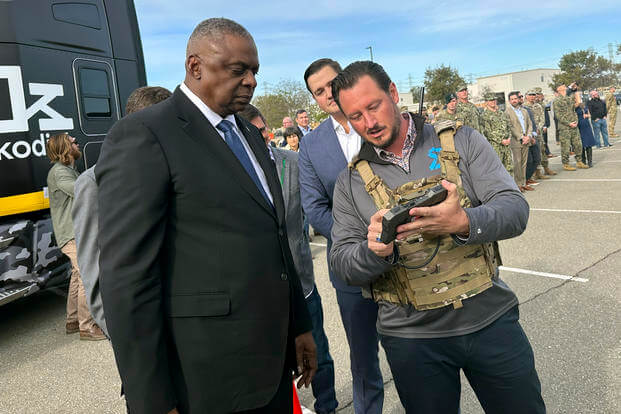MOUNTAIN VIEW, California (AP) — From underwater drones to electronic warfare, the U.S. is expanding its high-tech military cooperation with Australia and the United Kingdom as part of a broader effort to counter China’s rapidly growing influence in the Indo-Pacific.
Defense Secretary Lloyd Austin met with defense chiefs from Australia and the United Kingdom at the U.S. military’s defense technology hub in Silicon Valley on Friday to forge a new agreement to increase technology cooperation and information sharing. The goal, according to a joint statement, is to be able to better address global security challenges, ensure each can defend against rapidly evolving threats and to “contribute to stability and prosperity in the Indo-Pacific region and beyond.”
Austin met with Australian Defense Minister Richard Marles and Grant Shapps, the British secretary of state for defense, at the Defense Innovation Unit headquarters.
Speaking at a news conference after the meeting, Austin said the effort will, for example, rapidly accelerate the sophistication of the drone systems, and prove that “we are stronger together.”
The new technology agreement is the next step in a widening military cooperation with Australia that was first announced in 2021. The three nations have laid out plans for the so-called AUKUS partnership to help equip Australia with a fleet of eight nuclear-powered submarines. AUKUS is an acronym for Australia, the United Kingdom and the United States.
Under the deal, Australia will buy three Virginia-class submarines from the United States and build five of a new AUKUS-class submarine in cooperation with Britain. The subs, powered by U.S. nuclear technology, would not carry nuclear weapons and would be built in Adelaide, Australia, with the first one finished around 2040.
Marles said there has been an enormous amount of progress in the submarine program. He added that as an island nation, Australia has a need for improved maritime drones and precision strike capabilities.
And Shapps said that with China “undermining the freedom of navigation in the Indo-Pacific, we’ve never had a greater need for more innovation.” He said open navigation of the seas, including in the Pacific and the South China Sea, is critical.
According to officials, Australian Navy officers have already started to go through nuclear power training at U.S. military schools.
Earlier this year the U.S. announced it would expand its military industrial base by helping Australia manufacture guided missiles and rockets for both countries within two years. Under that agreement, they would cooperate on Australia’s production of Guided Multiple Launch Rocket Systems by 2025.
The enhanced cooperation between the nations has been driven by growing concerns about China’s burgeoning defense spending and rapidly expanding military presence in the region. Last year Beijing signed a security pact with Solomon Islands and raised the prospect of a Chinese naval base being established there.
The U.S. has increased its troop presence, military exercises and other activities in the region. U.S. relations with China have been strained in recent years, over trade, U.S. support for self-governing Taiwan, Beijing’s military buildup on a series of manmade islands, and a number of aggressive aircraft and ship encounters.
The new agreement also sets up a series of military exercises involving the use of undersea and surface maritime drones and improves the ability of the three countries to share intelligence and data collected by their sonobuoys. The buoys are used to detect submarines and other objects in the water.
It also calls for plans to expand the use of artificial intelligence, including on P-8A surveillance aircraft, to more quickly process data from the buoys in order to improve anti-submarine warfare. And it says the three countries will establish new radar sites to beef up their ability to detect and track objects in deep space.
High-tech demonstrations were set up across a large parking area at DIU and inside the headquarters, allowing Austin to take a few minutes before the start of the meeting to see a number of projects being developed, including a virtual training device that will help Ukrainian pilots learn to fly F-16 fighter jets and swarming drones being developed for warfighters. The projects aren’t tied to the Australian agreement, but reflect the ongoing effort by the three nations to improve technology — an area where China often has the lead.
As Austin walked through the exhibits, he was able to watch a swarm of five drones lift off from the pavement and hover over the onlookers — all controlled by a single worker with a small handheld module. The short-range reconnaissance drones — called the Skydio X2D — are already in use in combat, but the swarming technology and ability to control them all from a single device is still in development, said Skydio CEO Adam Bry.
Inside the DIU offices, Air Force Maj. Alex Horn demonstrated a new portable pilot-training module that will allow instructors in the United States to remotely coach trainees overseas using a virtual reality headset. Four of the so-called "Immersive Training Devices" will be delivered to Morris Air National Guard Base in Arizona next month and will be used to train Ukrainian pilots to fly F-16s.
Horn said the devices, which are cheaper than other systems, will help accelerate the training for Ukrainian pilots who are used to flying Soviet aircraft and need schooling on F-16 basics before moving to cockpit training.












